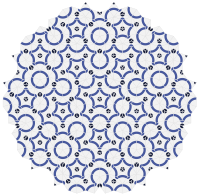
Back تبليط لادوري Arabic Neperiodické dláždění Czech Teselado aperiódico Spanish Pavage apériodique French Nemperiodikus csempézés Hungarian 비주기적 테셀레이션 Korean Апериодичная мозаика Russian Аперіодична мозаїка Ukrainian


An aperiodic tiling is a non-periodic tiling with the additional property that it does not contain arbitrarily large periodic regions or patches. A set of tile-types (or prototiles) is aperiodic if copies of these tiles can form only non-periodic tilings.
The Penrose tilings are a well-known example of aperiodic tilings.[1][2]
In March 2023, four researchers, David Smith, Joseph Samuel Myers, Craig S. Kaplan, and Chaim Goodman-Strauss, announced the proof that the tile discovered by David Smith is an aperiodic monotile, i.e., a solution to the einstein problem, a problem that seeks the existence of any single shape aperiodic tile.[3] In May 2023 the same authors published a chiral aperiodic monotile with similar but stronger constraints.[4]
Aperiodic tilings serve as mathematical models for quasicrystals, physical solids that were discovered in 1982 by Dan Shechtman[5] who subsequently won the Nobel prize in 2011.[6] However, the specific local structure of these materials is still poorly understood.
Several methods for constructing aperiodic tilings are known.
- ^ Gardner, Martin (January 1977). "Mathematical Games". Scientific American. 236 (1): 111–119. Bibcode:1977SciAm.236a.110G. doi:10.1038/scientificamerican0177-110.
- ^ Gardner, Martin (1988). Penrose Tiles to Trapdoor Ciphers. W H Freeman & Co. ISBN 978-0-7167-1987-8.
- ^ Smith, David; Myers, Joseph Samuel; Kaplan, Craig S.; Goodman-Strauss, Chaim (2023-03-19). "An aperiodic monotile". arXiv:2303.10798 [math.CO].
- ^ Smith, David; Myers, Joseph Samuel; Kaplan, Craig S.; Goodman-Strauss, Chaim (2023-05-28). "A chiral aperiodic monotile". arXiv:2305.17743 [math.CO].
- ^ Schechtman, D.; Blech, I.; Gratias, D.; Cahn, J.W. (1984). "Metallic Phase with long-range orientational order and no translational symmetry". Physical Review Letters. 53 (20): 1951–1953. Bibcode:1984PhRvL..53.1951S. doi:10.1103/PhysRevLett.53.1951.
- ^ "The Nobel Prize in Chemistry 2011". Nobelprize.org. Retrieved 2011-10-06.